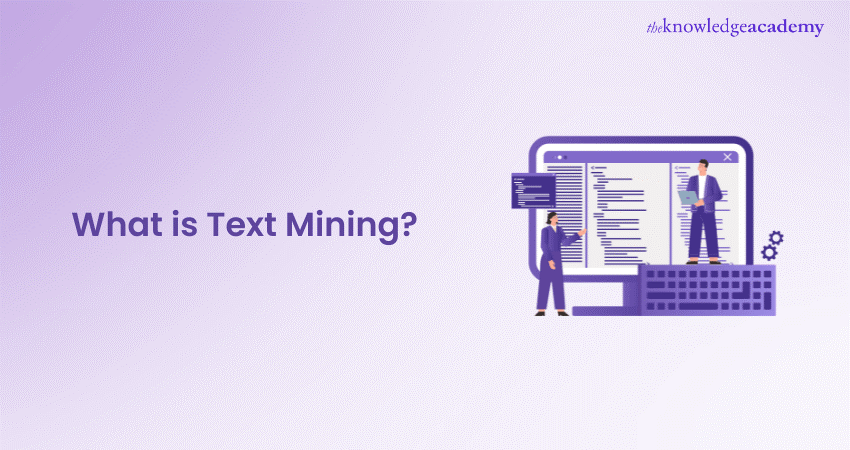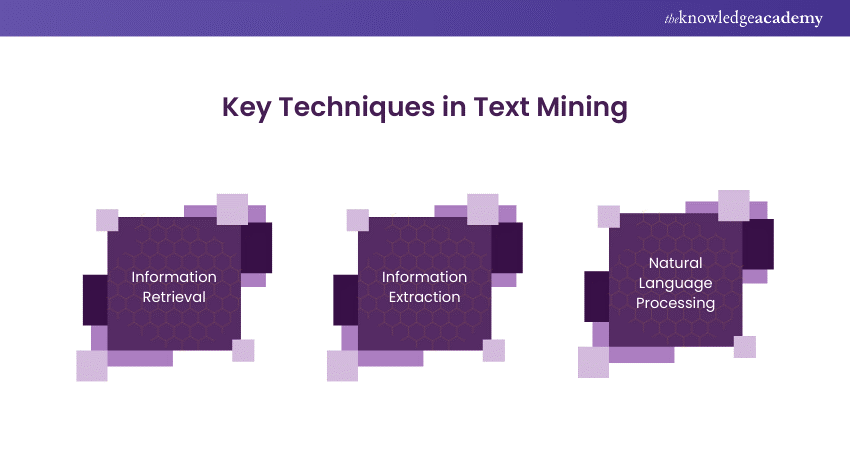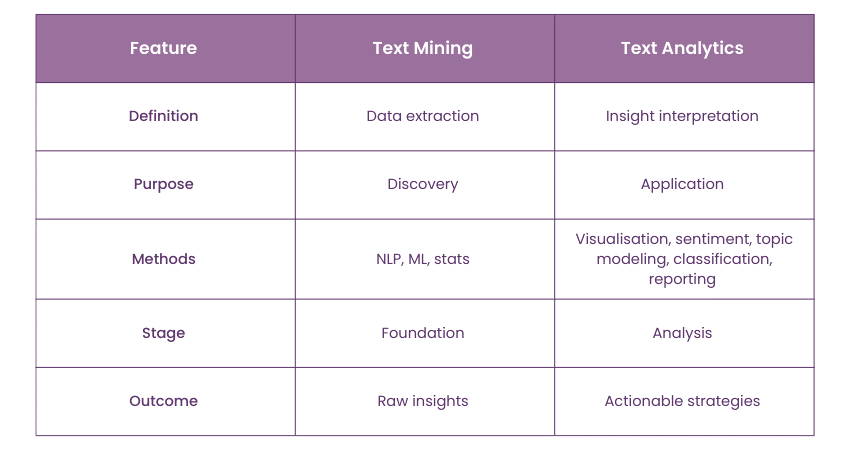We may not have the course you’re looking for. If you enquire or give us a call on + 1-866 272 8822 and speak to our training experts, we may still be able to help with your training requirements.
Training Outcomes Within Your Budget!
We ensure quality, budget-alignment, and timely delivery by our expert instructors.

Wondering how companies turn enormous textual data into valuable insights and information? The secret lies in Text Mining. Text Mining is a demanding skill for every Data Science aspirant, helping you develop practical data knowledge by gaining insights from a vast array of textual data, which includes customer reviews and social media posts. Continue reading this blog to explore What is Text Mining, its importance, key techniques, future benefits, limitations, etc. Read on to learn more!
Table of Contents
1) Understand What is Text Mining?
2) The Importance of Text Mining
3) Key Techniques in Text Mining
4) How Does Text Mining Work?
5) Benefits of Text Mining
6) Drawbacks of Text Mining
7) Text Mining vs Text Analytics: Key Differences
8) The Future of Text Mining
9) Conclusion
Understand What is Text Mining?
Text Mining is the set of methodologies and strategies that transform raw, unstructured textual data into insightful information, helping businesses to make informed decisions.
For example, a retail company can analyse its customers reviews on various social media channels to identify the common keywords like 'expensive' and 'quality issues.' Accordingly, it works to improve the quality of its products and make them budget-friendly for users.
The Importance of Text Mining
Text Mining is important for Data Scientists and other professionals, including marketers and business analysts. Listed below are some of its importance.
1) Transforming Unstructured Data Into Insights: Text Mining enhances business decision-making abilities by transforming unstructured data. Additionally, with the expansion of data from social media, emails, and reviews, organisations consistently need tools to identify extracurricular needs and trends.
2) Uncovering Sentiments and Opinions: Text Mining can easily discover sentiments and opinions in textual data using the NLP and Machine Learning (ML) applications. Moreover, by analysing customer feedback, Text Mining also helps businesses understand their preferences.
3) Facilitating Knowledge Discovery: Text Mining helps decode relationships and connections within larger datasets. This is beneficial in fields like healthcare, where analysing patient records can deliver relevant trends in treatment outcomes or disease prevalence, further promoting informed decision-making.
4) Enhancing Risk Management and Compliance: Text Mining also helps manage risk and compliance by monitoring communications for anomalies like fraud or regulatory violations.
Enhance your Python proficiency with our Python Data Science Course — sign up now!
Key Techniques in Text Mining
There are primarily three techniques used in Text Mining. These include:

1) Information Retrieval
Information retrieval is identifying relevant data from a large collection of text, helping users to quickly locate specific documents or pieces of information. The goal of such technique is to deliver the most impactful results based on users’ preferences and intents.
2) Information Extraction
Information extraction is the process of extracting specific information from a large set of unstructured textual data. For example, it can quickly identify names, dates, and locations in a specific document. This technique also helps businesses to organise data for analysis and usage purposes, making it easier to understand complex information.
3) Natural Language Processing
Natural Language Processing (NLP) is a branch of Artificial Intelligence (AI) that deals with how computers translate and interpret human language. This technique is preferred for machines to read, understand, and respond to text replicating human communication.
How Does Text Mining Work?
Text Mining works by discovering useful information sets of textual data. It involves:
1) Data Cleaning
Every text requires a cleanup before its analysis. This includes removing any unnecessary information, such as extra spaces, special characters, or reductant words. By performing data cleaning, texts get easier to work for the Data Analysts and Data Scientists.
2) Stemming
Stemming is a technique that converts words to their basic form, such as 'running from' 'ran,' and 'runner' to 'run.' This technique helps group similar words together, making it seamless for data professionals to analyse and interpret the meanings of these texts.
3) Tokenisation
Tokenisation is the process of splitting text into smaller packs, such as words or phrases. For instance, the sentence 'I love apples' would be categorised into three tokens: 'I,' 'love,' and 'apples.' This helps Data Analysts to examine each section of the text separately.
4) Parts of Speech Tagging
In ‘Part of Speech Tagging’, the role of each word in a sentence is categorised into nouns, verbs, or adjectives. For example, in the sentence 'The cat sits,' 'cat' is a noun, and 'sits' is a verb. The aim of this technique is to understand the morphology of texts.
5) Syntax Parsing
Syntax parsing is a technique that analyse the structure of sentences to understand their grammatical complexities. It helps us to see how different words and phrases fit together. For instance, it can show us in the phrase 'The quick brown fox,' 'quick' and 'brown' describe 'fox.' This technique is vital for data professionals to perform a thorough analysis of the text.
Refine your Data Mining skills—kickstart your Data Mining Training today!
Benefits of Text Mining
Text Mining comes with a plethora of benefits for users, such as:
1) Enhancing Operational Efficiency: Text Mining saves resources and time by automating data extraction and analysis. This allows for greater decision-making and accuracy.
2) Improving Patient Outcomes: Text Mining can also benefit heathcare industry by analysing clinical notes and patient records, causing better patient outcomes and lower costs.
3) Driving Strategic Decisions: It also helps organisations to harness text data, strategic decisions and operational efficiencies for long-term success.
Drawbacks of Text Mining
Unlike its widespread benefits, Text Mining has certain drawbacks that organisations must consider.
1) The Complexity of Natural Language Processing: The complexity of human language is comprised of numerous idioms, sarcasms, and contexts. This complexity can lead to misinterpretation via textual Data Analysis when employing Text Mining methods, impacting the outcomes.
2) Data Privacy and Ethical Concerns: Analysing large volumes of text, especially from personal sources, raises questions about data security. Organisations must balance using data for insights while respecting privacy rights and addressing the risk of biased algorithms.
3) Need for Human Oversight: Inaccuracies in Text Mining highlight the need for continual improvement and human oversight. Automated systems may misinterpret text, such as categorising sarcastic comments incorrectly, emphasising the importance of refining these technologies.
Text Mining vs Text Analytics: Key Differences
Text Mining and text analytics are sometimes used interchangeably. However, there is a significant difference between them. Listed below are those differences:

1) Definition
Text Mining: Text Mining is the process of obtaining useful information and patterns from unstructured text data by incorporating specific algorithms and techniques.
Text Analytics: In contrast, Text analytics is the application of Data Science that interprets and derives actionable insights from that Text Mining result.
2) Purpose
Text Mining: It focuses primarily on uncovering hidden insights, trends, and relationships in textual information.
Text Analytics: While text analytics emphasises understanding and applying the insights derived from Text Mining to boost their decision-making capabilities.
3) Methods
Text Mining: It involves methods like Natural Language Processing (NLP), Machine Learning, and Statistical Analysis.
Text Analytics: While text analytics utilises visualisation tools, Sentiment Analysis, and reporting methods as their primary methods.
4) Stage in Information Processing
Text Mining: Text Mining is the fundamental stage of the text Data Analytics process.
Text Analytics: While Text analytics is the latter process of analysing and interpreting insights for achieving business goals.
5) Outcome
Text Mining: It generates raw insights and patterns from unstructured data.
Text Analytics: It transforms those insights into actionable strategies and decisions.
Dive into Data Analysis excellence with our Pandas For Data Analysis Training – join today!
The Future of Text Mining
With the daily increase in unstructured data, Text Mining will be a frontrunner for organisations looking for actionable insights to improve their businesses. Furthermore, Artificial Intelligence (AI) and Machine Learning innovations will further improve the effectiveness of these text-mining tools.
This progress will also help businesses extract seamless and efficient insights from various sources, such as social media and customer reviews. Furthermore, by adopting more holistic approaches, organisations can complement traditional Data Mining and Big Data Analytics, resulting in an empowering multi-dimensional informational perspective.
Conclusion
We hope you understood 'What is Text Mining?' Text Mining is a crucial skill for Data Science enthusiasts that enables the transformation of unstructured data into valuable insights. Irrespective of the challenges faced by Text Mining, including data privacy concerns, the future of Text Mining seems promising and enlightening for Data Science aspirants.
Learn how to analyse data using Data Science With R Training – sign up now!
Frequently Asked Questions

Natural Language Processing (NLP) is a field of artificial intelligence that allows computers to understand and interpret human language. NLP and Text Mining together can help transform raw text into actionable information, further enhancing industry decision-making.

Text Mining in Python refers to the process of extracting useful information and insights from unstructured textual data using the applications Python programming. It involves techniques like Natural Language Processing (NLP) to analyse and interpret language patterns.

The Knowledge Academy takes global learning to new heights, offering over 30,000 online courses across 490+ locations in 220 countries. This expansive reach ensures accessibility and convenience for learners worldwide.
Alongside our diverse Online Course Catalogue, encompassing 19 major categories, we go the extra mile by providing a plethora of free educational Online Resources like News updates, Blogs, videos, webinars, and interview questions. Tailoring learning experiences further, professionals can maximise value with customisable Course Bundles of TKA.

The Knowledge Academy’s Knowledge Pass, a prepaid voucher, adds another layer of flexibility, allowing course bookings over a 12-month period. Join us on a journey where education knows no bounds.

The Knowledge Academy offers various Data Science Courses, including Text Mining Training, Python Data Science Course, and Data Science With R Training. These courses cater to different skill levels, providing comprehensive insights into Data Mining vs Data Analytics.
Our Data, Analytics & AI Blogs cover a range of topics related to Data Science and analytics, offering valuable resources, best practices, and industry insights. Whether you are a beginner or looking to advance your Data Analysis knowledge, The Knowledge Academy's diverse courses and informative blogs have got you covered.
Upcoming Data, Analytics & AI Resources Batches & Dates
Date
 Text Mining Training
Text Mining Training
Thu 6th Feb 2025
Thu 3rd Apr 2025
Thu 8th May 2025
Thu 10th Jul 2025
Thu 18th Sep 2025
Thu 6th Nov 2025







 Top Rated Course
Top Rated Course



 If you wish to make any changes to your course, please
If you wish to make any changes to your course, please


